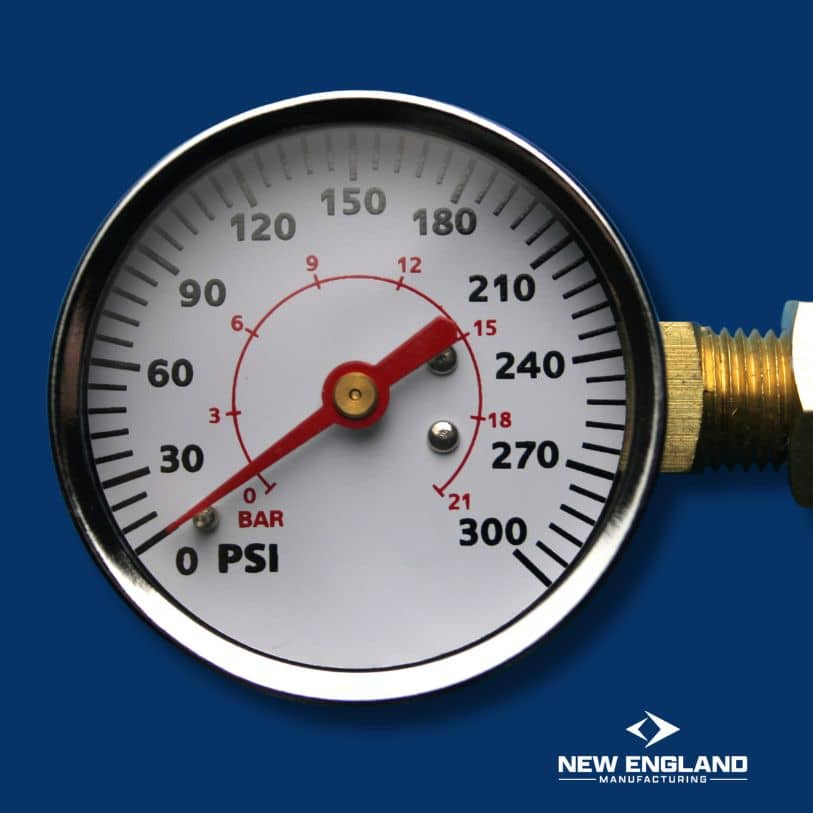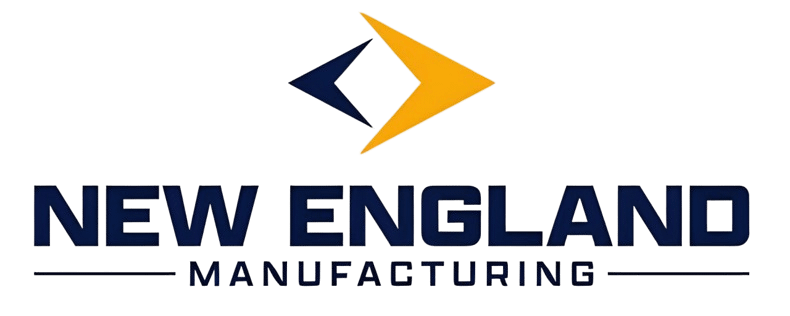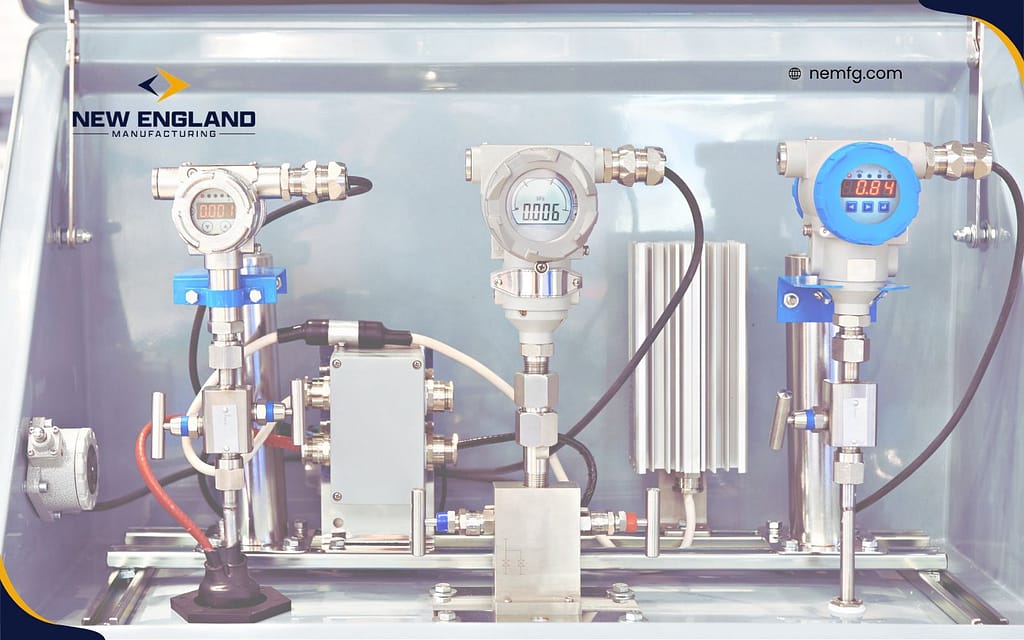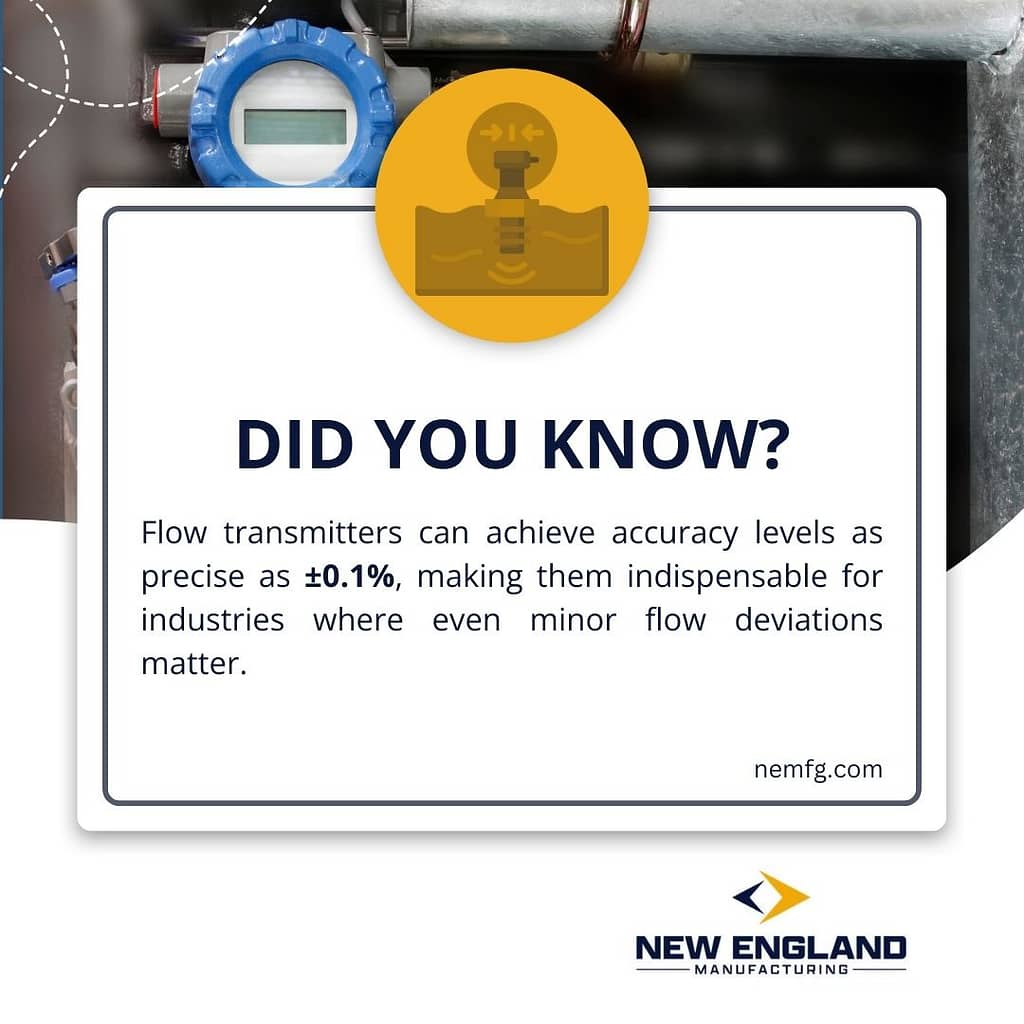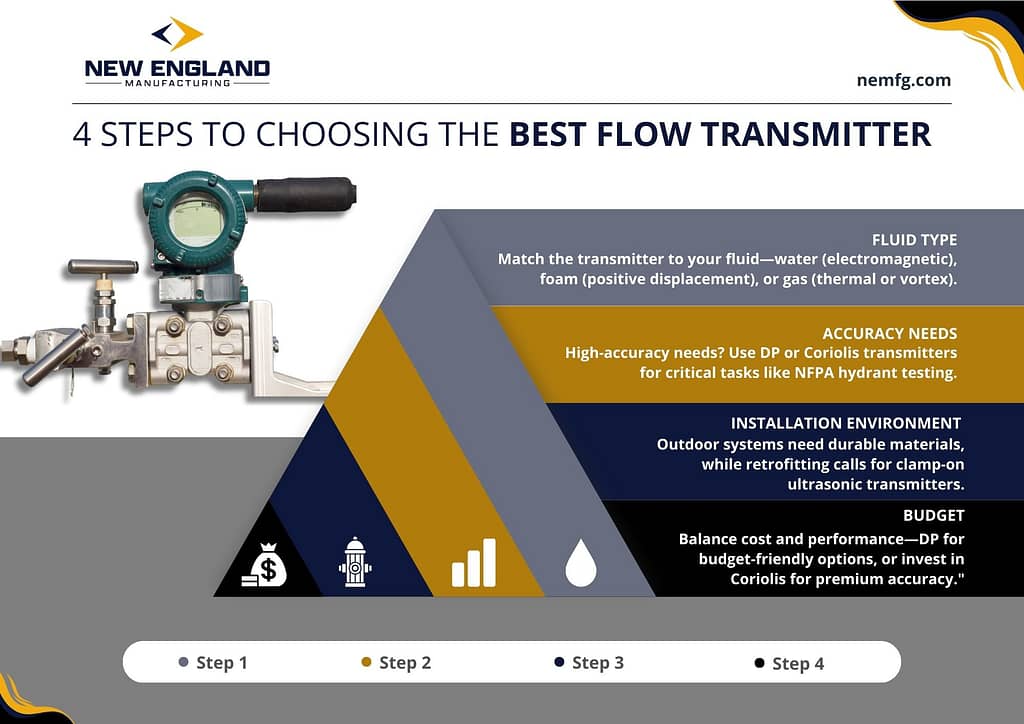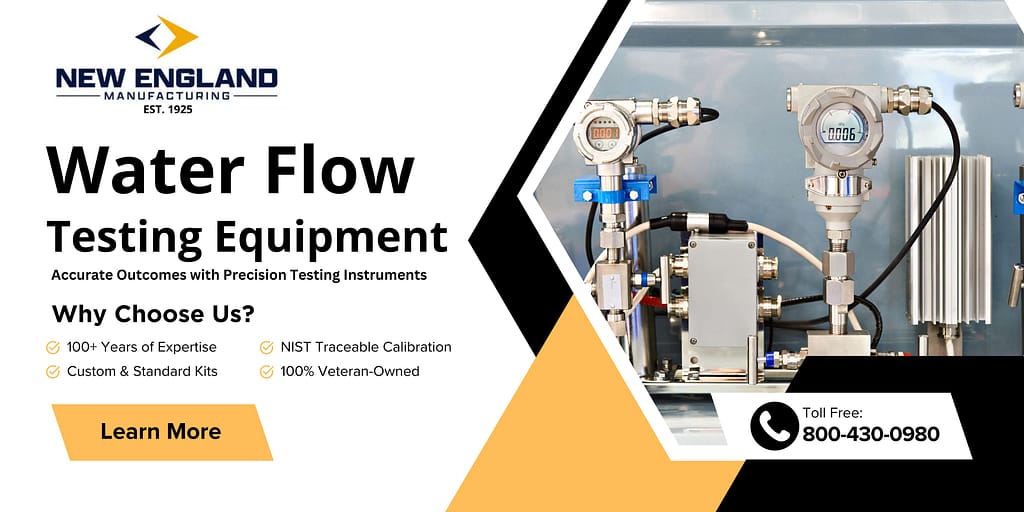15 Flow Transmitter Types: Key Advantages, Limitations & Applications
When a fire breaks out, every second counts and the reliability of your fire protection systems could mean the difference between containment and catastrophe. At the heart of these systems lies a critical component: flow transmitters.
Flow transmitters ensure accurate flow measurement, enabling firefighters, engineers, and safety inspectors to verify hydrant pressure, optimize pump performance, and meet strict safety standards.
For over 100 years, NEMFG has specialized in manufacturing precision equipment for fire hydrant testing and water flow analysis. Whether you’re a fire department ensuring hydrant readiness, an insurance underwriter assessing risk, or a contractor installing fire pumps, understanding flow transmitter types is key to selecting the right tools for your needs.
In this guide, we’ll break down 15 flow transmitter types, explaining how they work, their pros and cons, and where they excel in fire protection applications.
By the end, you’ll know exactly how to choose equipment that keeps fire suppression systems running flawlessly and why flow measurement is non-negotiable for safety and compliance.
 1. What Are Flow Transmitters? (Beginner-Friendly)
1. What Are Flow Transmitters? (Beginner-Friendly)
A flow transmitter is a device that measures the rate of liquid or gas moving through a system (like a pipe or fire hydrant) and transmits this data to monitoring equipment, alarms, or control systems.
Unlike basic flow meters, which only display measurements locally, transmitters send real-time information to operators, ensuring immediate visibility into system performance.
Why Flow Transmitters Matter in Fire Protection
- Critical Safety: They monitor water pressure and flow in fire suppression systems, ensuring hydrants, pumps, and sprinklers operate at required levels during emergencies.
- Hydrant & Pump Optimization: Accurate flow data is essential for fire hydrant testing and maintenance, helping identify issues like blockages or pressure drops before they compromise safety.
- Compliance Assurance: Insurance underwriters and regulators require verified performance data transmitters to provide the proof needed to meet NFPA standards and avoid fines.
For example: differential pressure transmitters (often paired with tools like Pitot tubes) are widely used in hydrant testing to calculate flow rates by measuring pressure differences.
This ensures firefighters can rely on hydrants to deliver water at the correct pressure during emergencies.
“In short, flow transmitters are vital for turning raw flow measurements into actionable insights, keeping fire protection systems reliable, efficient, and ready to perform.”
2. 15 Flow Transmitter Types
Choosing the right flow transmitter is critical for fire protection systems, where accuracy and reliability directly impact safety.
Below, we break down 15 types of transmitters, their core features, and how they apply to fire hydrant testing, pump monitoring, and other fire safety workflows.
| Type | Working Principle | Advantages | Limitations | Applications | Fire Protection Relevance |
| 1. Differential Pressure (DP) | Measures pressure drop (via Bernoulli’s equation) across obstructions like orifice plates or Venturi tubes. | Simple design, cost-effective, widely used. | Requires straight pipe sections; pressure loss. | Hydrant pressure testing, pipe flow monitoring. | Ensures hydrants meet NFPA pressure standards. |
| 2. Electromagnetic | Faraday’s Law: Voltage induced by conductive fluids moving through a magnetic field. | No moving parts, handles dirty liquids. | Only works with conductive fluids (e.g., water). | Water-based fire suppression systems. | Monitors sprinkler system flow without clogging. |
| 3. Coriolis Mass | Measures mass flow via tube vibration (Coriolis effect). | High accuracy, unaffected by fluid density changes. | Expensive, bulky. | Fuel flow in fire pumps, foam systems. | Ensures precise fuel delivery for pump operation. |
| 4. Ultrasonic | Uses sound waves (transit time/Doppler effect) to measure flow velocity. | Non-invasive, works on large pipes. | Less accurate with turbulent flow. | Retrofit installations, large water mains. | Verifies flow in hard-to-access fire mains. |
| 5. Thermal | Measures heat dissipation by fluid (gas-focused). | Ideal for gas flow, low maintenance. | Not suitable for liquids. | Compressed air systems, gas supply lines. | Monitors air pressure in foam suppression systems. |
| 6. Vortex | Detects vortex shedding frequency (Strouhal number) around a bluff body. | No moving parts, handles steam/compressed air. | Requires stable flow profiles. | Steam lines, compressed air systems. | Tracks steam supply for industrial fire systems. |
| 7. Turbine | Turbine rotates proportionally to flow rate. | High precision for clean liquids. | Clogs easily (e.g., hydrant sediment). | Fuel transfer, clean water systems. | Rare in fire protection due to debris risks. |
| 8. Positive Displacement | Traps fixed fluid volumes (e.g., pistons, gears). | Excellent for viscous fluids (foam agents). | High maintenance, pressure drop. | Foam suppression systems, fuel/oil transfer. | Ensures accurate foam mixing for firefighting. |
| 9. Open Channel | Converts water level (via weirs/flumes) to flow rate. | Low cost, simple installation. | Limited to open channels (e.g., ditches). | Stormwater management, drainage near fire stations. | Prevents flooding around fire facility infrastructure. |
| 10. Variable Area (Rotameter) | Float position in tapered tube indicates flow rate. | Visual readout, affordable. | Vertical installation only, limited accuracy. | Small-scale water/gas systems. | Rarely used in fire systems but helpful for basic checks. |
| 11. Paddlewheel | Paddlewheel spins with fluid flow; speed correlates to rate. | Low cost, easy installation. | Only for clean, low-viscosity liquids. | Irrigation, HVAC water systems. | Limited to auxiliary water supply monitoring. |
| 12. Laser Doppler | Measures light scattering by particles in flow. | Extremely precise, non-contact. | Expensive, requires particle presence. | Lab testing, R&D for fire systems. | Validates flow meter accuracy in controlled settings. |
| 13. Thermal Mass | Directly measures mass flow via heated elements. | No calibration needed for gas composition. | Limited to clean gases. | Compressed gas cylinders, inert gas systems. | Monitors CO2 or inert gas suppression systems. |
| 14. Averaging Pitot Tube | Averages pressure readings across multiple ports. | Handles uneven flow profiles. | Complex installation. | HVAC, large ducts. | Rare in fire protection but used in specialized ventilation systems. Pitot tube guide. |
| 15. Clamp-On Ultrasonic | External sensors measure flow via pipe wall vibrations. | No pipe modification, retrofittable. | Accuracy depends on pipe material/condition. | Legacy system upgrades, temporary testing. | Ideal for non-invasive fire hydrant flow verification. |
Key Takeaway: From hydrant testing (DP transmitters) to foam system monitoring (positive displacement), each transmitter type addresses unique fire safety challenges. Match your needs; whether cost, accuracy, or fluid type to ensure systems perform when lives depend on them.
Bonus: Cost, Maintenance, and Durability Comparison – Flow Transmitters
| Type | Typical Cost Range (USD) | Maintenance Needs | Installation Complexity | Accuracy Over Time | Durability (Harsh Conditions) |
| Differential Pressure (DP) | 500–3,000 | Low | Moderate | Stable with calibration | High (metal construction) |
| Electromagnetic | 2,000–10,000 | Low | Moderate | High | High (no moving parts) |
| Coriolis Mass | 5,000–20,000+ | Low | Complex | Very High | Moderate (sensitive to vibration) |
| Ultrasonic | 3,000–15,000 | Low | Simple | Moderate | High (non-invasive) |
| Thermal | 1,500–7,000 | Moderate | Simple | Moderate | Moderate (gas-focused) |
| Vortex | 2,500–8,000 | Low | Moderate | Stable | High (robust design) |
| Turbine | 1,000–5,000 | High | Moderate | Drifts with wear | Low (clogs easily) |
| Positive Displacement | 3,000–12,000 | High | Complex | High | Moderate (wear-prone parts) |
| Open Channel | 800–4,000 | Low | Simple | Moderate | High (outdoor-rated) |
| Variable Area (Rotameter) | 200–1,500 | Low | Simple | Low | Moderate (glass tubes fragile) |
| Paddlewheel | 300–2,000 | Moderate | Simple | Low | Low (mechanical wear) |
| Laser Doppler | 10,000–50,000+ | Low | Complex | Very High | High (lab-grade) |
| Thermal Mass | 2,000–9,000 | Low | Moderate | High | High (gas-compatible materials) |
| Averaging Pitot Tube | 1,000–5,000 | Low | Complex | Moderate | High (stainless steel) |
| Clamp-On Ultrasonic | 4,000–15,000 | Low | Simple | Moderate | High (no pipe contact) |
- Key Insight: While DP transmitters and rotameters offer budget-friendly options, Coriolis and laser Doppler types provide premium accuracy at a higher cost. For fire protection, prioritize durability (e.g., electromagnetic or vortex) and low maintenance to withstand demanding environments.
3. How to Choose the Right Flow Transmitter
Selecting the best flow transmitter for your fire protection system hinges on four key factors:
- Fluid Type:
-
-
- Water: Use electromagnetic or ultrasonic transmitters (no moving parts, handles clean/dirty water).
- Foam agents or viscous fluids: Opt for positive displacement transmitters.
- Gases: Thermal or vortex transmitters excel here.
-
- Accuracy Needs:
-
-
- Fire hydrant testing (NFPA 291) demands ±1% accuracy—DP transmitters or Coriolis are ideal.
- For general monitoring (e.g., pumps), ±2–3% accuracy (e.g., ultrasonic) suffices.
-
- Installation Environment:
-
-
- Harsh outdoor conditions? Prioritize stainless steel or clamp-on ultrasonic transmitters.
- Retrofitting old systems? Clamp-on sensors avoid pipe modifications.
-
- Budget:
-
- Low-cost: DP transmitters or rotameters (for basic checks).
- Long-term value: Electromagnetic (durable, low maintenance).
Why Trust NEMFG?
For over a century, NEMFG has engineered flow testing equipment specifically for fire protection. Our Pitot tubes and DP transmitters are trusted by fire departments nationwide for hydrant testing, while our fire pump systems ensure NFPA-compliant performance. Partner with us to balance cost, compliance, and reliability.
4. Importance in Fire Protection Systems
Case Study: Preventing Catastrophe with Accurate Transmitters
In 2022, a Midwest fire department discovered a 50% pressure drop in a hydrant during routine testing. Their differential pressure transmitter flagged the issue, which traced to a buried pipe collapse.
Repairs were made before winter (a season with high fire risks) Without that transmitter, the hydrant would have failed during a Christmas Eve warehouse fire, risking lives and $2M in property damage.
Regulatory Compliance
- NFPA Standards:
- Insurance Requirements:
Underwriters demand transmitter data to confirm systems meet ISO 9001 or FM Global standards. Non-compliance can void coverage or spike premiums.
Key Takeaway: Accurate flow transmitters aren’t just tools but safeguards against disasters and financial losses. By adhering to standards and investing in reliable equipment, fire departments ensure emergency readiness.
Conclusion
Flow transmitters are the backbone of reliable fire protection systems, ensuring hydrants, pumps, and suppression systems perform flawlessly when lives and property are on the line. From differential pressure transmitters for hydrant testing to ultrasonic sensors for non-invasive monitoring, choosing the right equipment is critical for safety, compliance, and peace of mind.
At New England Manufacturing (NEMFG), we’ve been trusted for nearly a century to deliver precision water flow testing equipment. Our Pitot tubes, pressure gauges, and custom kits are designed to meet NFPA standards and exceed expectations because when it comes to fire safety, there’s no room for error.
Ready to equip your fire protection system with industry-leading tools? NEMFG is here to help. As a 100% veteran-owned and operated company, we pride ourselves on exceptional customer service and high-quality products, including:
- Fire Hydrant Flow Test Kits: Custom or standard options with NIST traceable certification.
- Pressure Gauges: Precision-calibrated for accurate readings.
- Pitot Tubes: Essential for NFPA-compliant hydrant testing.
Why Choose NEMFG?
- Fast Shipping: Most orders ship within one business day.
- Expertise: Over 50 years of experience in water flow testing.
- Veteran-Owned: Supporting those who serve, both past and present.
📞 Call us today at 304-822-8011 or 800-430-0980 (Toll-Free) to discuss your needs or place an order. You can also email us at sales@nemfg.com for more information.
“Don’t compromise on fire safety- trust NEMFG for equipment that performs when it matters most”

Mark R.
With a strong foundation in industrial safety and fire protection systems, Mark R. specializes in creating clear, technical, and compliance-driven content. Writing for SafeTech Reports, he covers topics such as fire hydrant testing, PPE protocols, emergency procedures, and smart technology integration in safety systems. His work ensures that professionals stay informed on the latest regulations, best practices, and emerging trends in safety and infrastructure maintenance.
Get in touch
We usually respond within 24 hours
Need Reliable Water Flow Test Equipment?
For over 70 years, New England Manufacturing has been the trusted source for fire hydrant and water flow testing kits. From pitot gauge kits to custom test kits, we provide precision, durability, and expert calibration to meet your needs.
- Custom-built test kits
- High-quality pressure gauges
- Reliable calibration services
